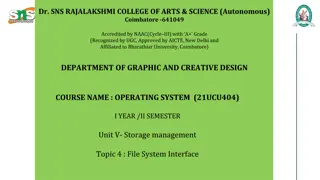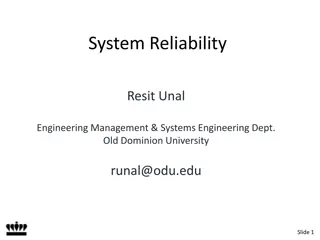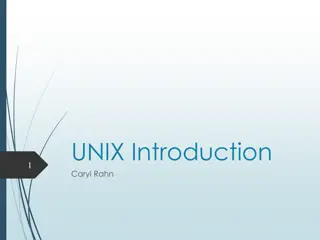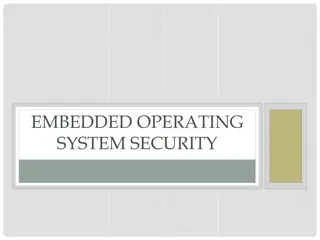Organizing Operating Systems for Efficiency and Reliability
Operating systems are complex and constantly evolving, with the challenge of managing bugs to ensure smooth operation. Different system structures such as monolithic, layered, and microkernel-based systems offer varying levels of organization and fault tolerance. Microkernel systems, exemplified by MINIX 3, prioritize modularity, flexibility, and extensibility, enhancing safety and correctness through server isolation. These structures provide insights into optimizing OS organization to prevent system disruptions.
Download Presentation

Please find below an Image/Link to download the presentation.
The content on the website is provided AS IS for your information and personal use only. It may not be sold, licensed, or shared on other websites without obtaining consent from the author. Download presentation by click this link. If you encounter any issues during the download, it is possible that the publisher has removed the file from their server.
E N D
Presentation Transcript
CS6456: Graduate Operating Systems Brad Campbell bradjc@virginia.edu https://www.cs.virginia.edu/~bjc8c/class/cs6456-f19/ 1
Problem Operating systems are large They continue to evolve and grow and are worked on by many people (Like all other programs) they contain bugs How to organize them so that bugs do not bring down systems impede normal operation etc. 2
Operating System Structures Monolithic systems Formerly called the big mess Layered systems Microkernel based systems Exokernels 3
Operating System Structures Monolithic systems Formerly called the big mess Layered systems A faulty driver or component can corrupt any data in kernel Arbitrary damage Stop system anywhere etc. Microkernel based systems Exokernels 4
Layered Systems Figure 1-25. Structure of the THE operating system. 5
Layered Systems Simple Elegant Incredibly na ve Figure 1-25. Structure of the THE operating system. 6
Microkernel An Organizing Principle Partition OS kernel into lots of small, independent pieces Put pieces in separate processes Isolated from each other except for message passing Keep kernel mode code to a minimum Concept emerged in 1970s MACH at CMU (Rick Rashid) NEXT computer Apple Mac-OS 7
Microkernel Example Works great on a PDP-11 Figure 1-26. Structure of the MINIX 3 system. Memory addressable device registers Minimal interrupt handling, scheduling, IPC, etc No virtual memory management 8
Major Advantages Modularity Flexibility and extensibility Easier to replace modules fewer dependencies Different servers can implement the same service in different ways Safety (each server is protected by the OS from other servers) Servers are largely hardware independent Correctness Easier to verify a small kernel Servers are isolated; errors in one don t affect others
Major Disadvantages of Early Microkernels Slow due to cross-domain information transfers? Server-to-OS, OS-to-server IPC is thought to be a major source of inefficiency Much faster to communicate between two modules that are both in OS
Microkernel Issues Virtual memory management Needs to interact directly with scheduler Page faults, etc. Kernel support for user-space threads Fast I/O devices Quick, responsive interrupts Top- and bottom-halves for interrupt handlers Interprocess communication 11
Example Systems Windows NT: introduced HAL layer to support hardware independence. Other layers not very small Amoeba (Tanenbaum s research based OS) Chorus Mach (CMU and DARPA) was the basis for the MAC OS/X and GNU HURD L4 is a family of publicly available microkernels
Microkernels A good idea in the 1970s and 80s Not up to demands of modern processors Virtual memory Heavy caching Not up to demand of modern operating systems L4 microkernel shows that it is possible to achieve well performing - kernels through processor-specific implementations of processor-independent abstractions. 13
Former Microkernel Resurrection Mobile phones, PDAs, handheld devices Fixed or limited functionality No general purpose files No dynamic virtual memory Simple context switches All code already in memory Easy IPC 14
Motivation for Extensibility The traditional OS provides various abstractions of system resources (virtual address spaces, processes, files, interprocess communication) Provides general-purpose resource management algorithms System calls define user interface to OS Able to handle most applications, but handles no applications perfectly because there s no easy way to specialize the OS to individual needs. Make operating systems more responsive to applications needs; e.g., Do your own scheduling Choose your own page replacement algorithm
Cost of High-Level Abstractions OS use of high-level abstractions hides info that applications could use to manage their own resources; e.g. Database systems may be forced to build random-access files on top of the OS file system Performance and functionality are limited A large, unmodifiable OS can t easily incorporate new research developments.
Exokernels Are a type of OS architecture, not a specific example. They separate resource allocation & protection (in the kernel) from resource management (done at user level with user-level library operating systems) Aegis is an example exokernel; EXOS is an example library OS.
Extensibility Mechanisms Exokernels rely on application-specific library operating systems to provide user modifications. SPIN relies on application-specific kernel extensions for the same purpose. Exokernels are incomplete without a library OS; SPIN is a complete OS that can be modified/extended.
What an Exokernel Does Multiplexes the hardware directly Instead of providing an abstraction of the hardware an exokernel makes specific hardware resources directly available to user level applications; e.g., disk blocks instead of files Provides primitives for secure management of physical resources; applications use them to develop appropriate abstractions. https://pdos.csail.mit.edu/archive/exo
Secure Bindings Secure bindings separate resource authorization from resource usage Protection checks are applied at binding time; checks at resource access time become simple and straightforward. Simply put, a secure binding allows the kernel to protect resources without understanding them.
Library Operating Systems Untrusted - Built on top of an exokernel Can be tailored to a set of applications with similar requirements. Run in user space fewer system calls to the exokernel => enhanced performance. Applications can interact with a library OS or interface directly to the exokernel. Possible to provide a standard interface (e.g. POSIX) for a familiar look.
Summary Exokernels are responsible for resource allocation/protection, user applications are responsible for resource management. Exokernel primitives can be implemented efficiently because they are simple Low-level multiplexing of hardware is fast. Library OSs enable applications to create appropriate abstractions. Secure bindings provide protections
The Multikernel: A new OS architecture for scalable multicore systems New hardware brings diversity Diversity in systems, diversity in cores, diversity in multiprocessor architectures How to program with increasingly complex architectures and memory layouts?
Multikernel Key Points 1.Make all inter-core communication explicit. 2.Make OS structure hardware-neutral. 3.View state as replicated instead of shared.
Make all inter-core communication explicit. Inter-core communiation uses explicit messages Avoids shared memory Multiprocessors look more and more like networks Using messages allows easy pipelining/batching Makes interconnect use more efficient Automated analysis/formal verification Calculi for reasoning about concurrency
Argument: message passing cheaper than shared memory 29
Make OS structure hardware-neutral. Separate OS structure from physical instantiation: abstraction! Only message transport and hardware interfaces are machine-specific Minimizes code change to OS Separate IPC protocols from hardware implementation Performance/extensibility benefits
View state as replicated instead of shared. Shared state is accessed as a local replica Shared state consistency through messages Consistency reqs tunable using diff protocols Reduces interconnect traffic and synchronization overhead Fault-tolerant to failures in CPUs


























